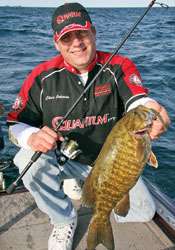
In his never-ending pursuit of trophy smallmouth, Chris Johnson often works the abyss.
Along with trophy fish, the Wisconsin fishing guide has also found an uncrowded strike zone that remains far outside of the normal angler’s mind-set.
Targeting depths of 100 feet or more, Johnson has learned how to consistently catch big bass in Lake Michigan. And his technique could be one that other bass fishermen want to learn more about. It’s not just bottom dredging the depth, either. In fact, Johnson, the vice president of the Wisconsin B.A.S.S. Federation Nation, has caught big smallmouth from schools suspended 28 feet deep over 103 feet of water.Impossible, you say?Johnson begins venturing into the abyss during the fall months on the Great Lakes. Once the water temperatures drop into the 40- to 50-degree range, he said, big bass begin following a series of shelves until finally reaching depths as deep as 120 feet for their winter range.
Last November, for example, Johnson and a client caught more than 30 bass, each weighing more than 3 1/2 pounds, while focusing on the shelves and working their way out to 70-foot depths.As I kept moving out, I kept seeing more balls of baitfish and more bass,” recalled Johnson, referring to the images on his electronics.”There were a number of sharp breaks going down from 26 feet to 102 feet, and on the bottom of those steep breaks were boulders the size of Volkswagens.”Johnson explained that the fish were tucked into the backside of the boulders where they were somewhat sheltered from current.Presenting a drop shot rig vertically works best for Johnson when he probes for deep smallmouth. He uses a 4-inch Strike King 3X Finesse Worm (green pumpkin) rigged wacky style on a No. 1 Gamakatsu drop shot hook. He ties the hook anywhere between 8 to 22 inches above a 3/4-ounce hand-poured bell sinker.Johnson’s total package for this deep technique includes a Quantum SuperLite PT 7-4 spinning rod matched with a Quantum Tour Edition spinning reel spooled with 10-pound-test Sufix Performance Braid. He also uses a 3- to 4-foot leader of 8-pound Seaguar InvizX Fluorocarbon.”With that 3/4-ounce weight in 102 feet of water, it took about 45 seconds for the rig to hit the bottom,” admitted Johnson. “All the fish we caught along the shelves were pretty tight to the bottom.”The Wisconsin guide varies his retrieve until the fish “give him an idea” of how to present his lure. “It seems like each school of fish that I find wants it different ways. Sometimes the fish want the lure held steady, and in other instances the fish want it shaken.”If you are beginning to think this Great Lakes technique won’t work in your area, think again.The deep, clear waters of highland-type reservoirs also draw plenty of smallmouth into the abyss.
Just ask Elite Series pro Brian Snowden of Missouri, who often finds smallmouth holding in deep water on his home lake of Table Rock — and at nearby Bull Shoals Lake. Again, this deep structure pattern takes place in the fall when the thermocline disappears.”The fish start moving all over then,” said Snowden. “There are some shallow and some deep. We see some as deep as 70 to 80 feet because of the fall turnover that allows the fish to go wherever they want in the water column.”When this deep water event occurs, Snowden opts for two lures, a Gitzit-type plastic and a jigging spoon. He prefers a smoke/salt ‘n pepper or smoke/purple flake tube, rigging it on a 3/8-ounce jighead when facing calm, sunny conditions. When the wind churns the surface and begins pushing water under cloudy skies, he opts for a 3/4-ounce Bass Pro Shops Strata SpoonTypically, Snowden looks for points near creek channels to probe for deep smallmouth.”I see the fish on my graph and vertically drop the lure to the fish. Or, a lot of times when the fish are tight to the bottom on gravel, I just drag the tube,” said Snowden.When dragging the tube, Snowden uses baitcasting equipment and 10-pound-test line. For the tube, he switches to spinning tackle and 6- to 8-pound-test line for vertical jiggingThe spoon works best for Snowden when he employs a hopping presentation. “I use short, quick, upward motions on the rod and then let the spoon flutter down 1 to 2 feet,” said Snowden. The three-time Bassmaster Classic qualifier relies on 14- to 17-pound-test line for the spoon in open water but favors 17-pound-test line when he hops the lure through submerged timber.So take it from the experts: Whether you’re fishing a natural lake or reservoir, you can avoid the crowds and catch plenty of smallmouth by dropping your lures into the abyss.
| |
For more great stories and the latest bass fishing news, subscribe to BASS Times. Call 877-BASS-USA to order today. |





